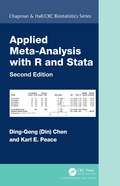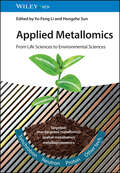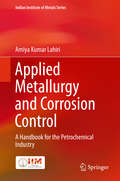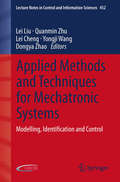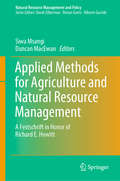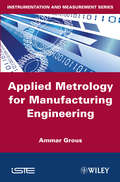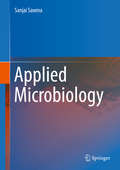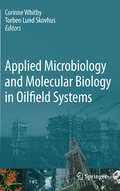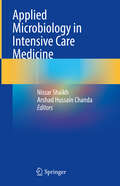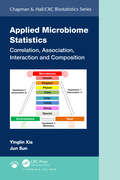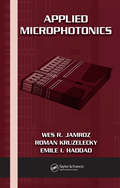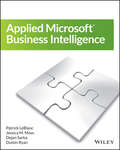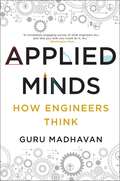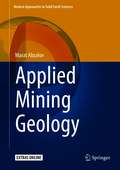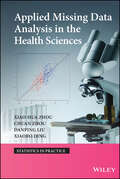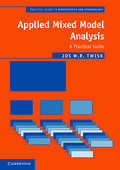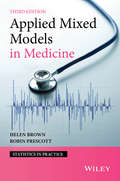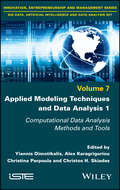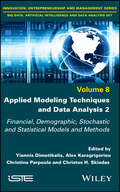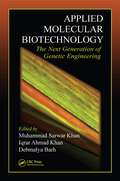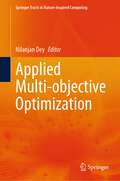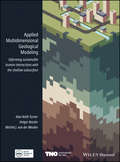- Table View
- List View
Applied Meta-Analysis with R and Stata (Chapman & Hall/CRC Biostatistics Series)
by Ding-Geng (Din) Chen Karl E. PeaceReview of the First Edition: The authors strive to reduce theory to a minimum, which makes it a self-learning text that is comprehensible for biologists, physicians, etc. who lack an advanced mathematics background. Unlike in many other textbooks, R is not introduced with meaningless toy examples; instead the reader is taken by the hand and shown around some analyses, graphics, and simulations directly relating to meta-analysis… A useful hands-on guide for practitioners who want to familiarize themselves with the fundamentals of meta-analysis and get started without having to plough through theorems and proofs. —Journal of Applied Statistics Statistical Meta-Analysis with R and Stata, Second Edition provides a thorough presentation of statistical meta-analyses (MA) with step-by-step implementations using R/Stata. The authors develop analysis step by step using appropriate R/Stata functions, which enables readers to gain an understanding of meta-analysis methods and R/Stata implementation so that they can use these two popular software packages to analyze their own meta-data. Each chapter gives examples of real studies compiled from the literature. After presenting the data and necessary background for understanding the applications, various methods for analyzing meta-data are introduced. The authors then develop analysis code using the appropriate R/Stata packages and functions. What’s New in the Second Edition: Adds Stata programs along with the R programs for meta-analysis Updates all the statistical meta-analyses with R/Stata programs Covers fixed-effects and random-effects MA, meta-regression, MA with rare-event, and MA-IPD vs MA-SS Adds five new chapters on multivariate MA, publication bias, missing data in MA, MA in evaluating diagnostic accuracy, and network MA Suitable as a graduate-level text for a meta-data analysis course, the book is also a valuable reference for practitioners and biostatisticians (even those with little or no experience in using R or Stata) in public health, medical research, governmental agencies, and the pharmaceutical industry.
Applied Metal Forming
by Henry S. ValbergApplied Metal Forming: Using FEM Analysis describes metal forming theory and how experimental techniques can be used to study any metal forming operation with great accuracy. For each primary class of processes, such as forging, rolling, extrusion, wiredrawing, and sheet-metal forming, it explains how FEA (Finite Elements Analysis) can be applied with great precision to characterize the forming condition and in this way optimize the processes. FEA has made it possible to build very realistic FEM-models of any metal forming process, including complex three-dimensional forming operations, in which complex products are shaped by complex dies. Thus, using FEA it is now possible to visualize any metal forming process and to study strain, stresses, and other forming conditions inside the parts being manufactured as they develop throughout the process.
Applied Metallomics: From Life Sciences to Environmental Sciences
by Yu-Feng Li Hongzhe SunApplied Metallomics A groundbreaking survey of a field that unites the sciences The metallome of a cellular compartment, such as an enzyme, is the variety and arrangement of its metal ions. Metallomics is the multidisciplinary study of the metallome and its many important interactions with biological molecules and systems. It exists at the intersection of biochemistry and materials science, offering crucial insights into biological processes in which iron, for instance, plays a pivotal role. Applied Metallomics is an up-to-the-minute overview of research developments in metallomics, offering both analysis and applications in a vast array of scientific and industrial areas. Moving freely between material science, environmental science, health science, and more, it offers a comprehensive survey of this interdisciplinary research area. As the field of metallomics continues to develop and its applications expand, this book will only be a need of the hour Applied Metallomics readers will also find: Detailed treatment of nanometallomics, environmetallomics, agrometallomics, and many more Coverage of machine learning and artificial intelligence techniques with applications in metallomics An author team with vast international research experiences Applied Metallomics is ideal for researchers in many areas touched by metallomics, that include chemistry, biochemistry, biotechnology, bioinorganic chemistry, and more.
Applied Metallurgy and Corrosion Control: A Handbook for the Petrochemical Industry (Indian Institute of Metals Series)
by Amiya Kumar LahiriThis book serves as a comprehensive resource on metals and materials selection for the petrochemical industrial sector. The petrochemical industry involves large scale investments, and to maintain profitability the plants are to be operated with minimum downtime and failure of equipment, which can also cause safety hazards. To achieve this objective proper selection of materials, corrosion control, and good engineering practices must be followed in both the design and the operation of plants. Engineers and professional of different disciplines involved in these activities are required to have some basic understanding of metallurgy and corrosion. This book is written with the objective of servings as a one-stop shop for these engineering professionals. The book first covers different metallic materials and their properties, metal forming processes, welding, and corrosion and corrosion control measures. This is followed by considerations in material selection and corrosion control in three major industrial sectors, oil & gas production, oil refinery, and fertilizers. The importance of pressure vessel codes as well as inspection and maintenance repair practices have also been highlighted. The book will be useful for technicians and entry level engineers in these industrial sectors. Additionally, the book may also be used as primary or secondary reading for graduate and professional coursework.
Applied Methods and Techniques for Mechatronic Systems: Modelling, Identification and Control (Lecture Notes in Control and Information Sciences #452)
by Lei Liu Quanmin Zhu Lei Cheng Yongji Wang Dongya ZhaoApplied Methods and Techniques for Mechatronic Systems brings together the relevant studies in mechatronic systems with the latest research from interdisciplinary theoretical studies, computational algorithm development and exemplary applications. Readers can easily tailor the techniques in this book to accommodate their ad hoc applications. The clear structure of each paper, background - motivation - quantitative development (equations) - case studies/illustration/tutorial (curve, table, etc. ) is also helpful. It is mainly aimed at graduate students, professors and academic researchers in related fields, but it will also be helpful to engineers and scientists from industry. Lei Liu is a lecturer at Huazhong University of Science and Technology (HUST), China; Quanmin Zhu is a professor at University of the West of England, UK; Lei Cheng is an associate professor at Wuhan University of Science and Technology, China; Yongji Wang is a professor at HUST; Dongya Zhao is an associate professor at China University of Petroleum.
Applied Methods for Agriculture and Natural Resource Management: A Festschrift in Honor of Richard E. Howitt (Natural Resource Management and Policy #50)
by Siwa Msangi Duncan MacEwanThis book assesses recent developments in the analysis of agricultural policy and water resource management, and highlights the utility and theoretical rigor of quantitative methods for modeling agricultural production, market dynamics, and natural resource management. In diverse case studies of the intersection between agriculture, environmental quality and natural resource sustainability, the authors analyze economic behavior - both at aggregate as well as at individual agent-level - in order to highlight the practical implications for decision-markers dealing with environmental and agricultural policy. The volume also addresses the challenges of doing robust analysis with limited data, and discusses the appropriate empirical approaches that can be employed. The studies in this book were inspired by the work of Richard E. Howitt, Emeritus Professor of Agricultural Economics at the University of California at Davis, USA, whose career has focused on the application of robust empirical methods to address concrete policy problems.
Applied Metrology for Manufacturing Engineering (Wiley-iste Ser.)
by Ammar GrousApplied Metrology for Manufacturing Engineering, stands out from traditional works due to its educational aspect. Illustrated by tutorials and laboratory models, it is accessible to users of non-specialists in the fields of design and manufacturing. Chapters can be viewed independently of each other. This book focuses on technical geometric and dimensional tolerances as well as mechanical testing and quality control. It also provides references and solved examples to help professionals and teachers to adapt their models to specific cases. It reflects recent developments in ISO and GPS standards and focuses on training that goes hand in hand with the progress of practical work and workshops dealing with measurement and dimensioning.
Applied Microbiology
by Sanjai SaxenaThe book is oriented towards undergraduates science and engineering students; postgraduates and researchers pursuing the field of microbiology, biotechnology, chemical - biochemical engineering and pharmacy. Various applications of microorganisms have been covered broadly and have been appropriately reflected in depth in 12 different chapters. The book begins with an insight to the diverse niche of microorganisms which have been explored and exploited in development of various biotechnological products and green processes. Further, how these microorganisms have been genetically modified to improve the desired traits for achieving optimal production of microbially derived products is discussed in the second chapter. Major route of production of microbially derived products and processes is through fermentation technology and therefore due emphasis on different aspects of fermentation technology has been given in the subsequent chapter. The development and deployment of biopesticides and biofertilizers which find tremendous application have been separately discussed under agricultural applications. Application of microbes for the removal of pollutants, recovery of metals and oils has also been discussed under environmental applications. The role of microbial systems in development of fermented foods and beverages have also been discussed in Chapter 6. The application of microbes in production of commodity chemicals and fine chemicals has also been discussed in separate chapters. A chapter has been dedicated to the tremendous applications of microbially produced enzymes in different industrial sectors. Another unique facet of this book is explaining the different methods by which desired traits of microorganisms have been improved for their efficacious and economical exploitation in the industry. A chapter is dedicated to exploitation of microorganisms in development of vaccines for human and veterinary use. Finally, the last chapter discusses the role of immobilization in optimization of industrial processes and development of microbial biosensors for industrial applications. Thus, this book is a holistic approach providing information on the present applications of microorganisms.
Applied Microbiology and Molecular Biology in Oilfield Systems: Proceedings from the International Symposium on Applied Microbiology and Molecular Biology in Oil Systems (ISMOS-2), 2009
by Torben Lund Skovhus Corinne WhitbyApplied Microbiology and Molecular Biology in Oil Field Systems addresses the major problems microbes cause in oil fields, (e.g. biocorrosion and souring) and how beneficial microbial activities may be exploited (e.g. MEOR and biofuels). The book describes theoretical and practical approaches to specific Molecular Microbiological Methods (MMM), and is written by leading authorities in the field from both academia and industry. The book describes how MMM can be applied to faciliate better management of oil reservoirs and downstream processes. The book is innovative in that it utilises real industrial case studies which gives useful technical and scientific information to researchers, engineers and microbiologists working with oil, gas and petroleum systems.
Applied Microbiology in Intensive Care Medicine
by Nissar Shaikh Arshad Hussain ChandaThis book covers microbiological features of the diseases that require intensive care support, including iatrogenic and hospital-acquired infections. The knowledge will assist in the early diagnosis and treatment of bacterial, viral, and fungal infections requiring critical care admission to improve patient outcomes. All microbiological and therapeutic concerns and management of infectious disorders of all human body systems, from the brain to the musculoskeletal system, are addressed. It also describes practical and descriptive ways to prevent, diagnose, and manage various known and forthcoming healthcare-associated illnesses, ranging from MRSA to VRE and others. Applied Microbiology in Intensive Care Medicine will benefit not only intensive and critical care practitioners but also infectious disease practitioners and physicians, surgeons, intensivists, clinical pharmacists, nurses, and technicians in intensive care units.
Applied Microbiome Statistics: Correlation, Association, Interaction and Composition (Chapman & Hall/CRC Biostatistics Series)
by Jun Sun Yinglin XiaThis unique book officially defines microbiome statistics as a specific new field of statistics and addresses the statistical analysis of correlation, association, interaction, and composition in microbiome research. It also defines the study of the microbiome as a hypothesis-driven experimental science and describes two microbiome research themes and six unique characteristics of microbiome data, as well as investigating challenges for statistical analysis of microbiome data using the standard statistical methods. This book is useful for researchers of biostatistics, ecology, and data analysts. Presents a thorough overview of statistical methods in microbiome statistics of parametric and nonparametric correlation, association, interaction, and composition adopted from classical statistics and ecology and specifically designed for microbiome research. Performs step-by-step statistical analysis of correlation, association, interaction, and composition in microbiome data. Discusses the issues of statistical analysis of microbiome data: high dimensionality, compositionality, sparsity, overdispersion, zero-inflation, and heterogeneity. Investigates statistical methods on multiple comparisons and multiple hypothesis testing and applications to microbiome data. Introduces a series of exploratory tools to visualize composition and correlation of microbial taxa by barplot, heatmap, and correlation plot. Employs the Kruskal–Wallis rank-sum test to perform model selection for further multi-omics data integration. Offers R code and the datasets from the authors’ real microbiome research and publicly available data for the analysis used. Remarks on the advantages and disadvantages of each of the methods used.
Applied Microphotonics (Optical Science and Engineering)
by Wes R. Jamroz Roman Kruzelecky Emile I. HaddadAs the limits of electrical performance come within sight, photons are poised to take over for the electron. But the search continues for the materials, topologies, and fabrication technologies capable of producing photonic devices at a reasonable speed and cost. Taking a fundamentallook at the development of photonic technology from the macro- to the microscale, Applied Microphotonics introduces the major principles and technologies underlying the field.Following an overview of historical and commercial driving forces, the authors briefly review the underlying physics, emphasizing the practical and design implications for photonic systems. This general discussion lays the foundation for the remainder of the book, where the authors first introduce the photonic node and then discuss each subsystem in detail, including transmitters, couplers and switches, multiplexers and demultiplexers, receivers, amplifiers, and compensators. The following chapters explore new technologies such as photonic band gap structures, materials and fabrication processes, integration methodologies, and advanced devices such as photonic computers. The book concludes with a brief introduction to quantum photonics and a forward look at potential directions of photonics. Applied Microphotonics encapsulates the recent push toward all-optical networks and devices with an applications-oriented perspective. It is ideal for newcomers to the field as well as anyone curious to know how photonic technology can benefit their own field.
Applied Microsoft Business Intelligence
by Patrick Leblanc Jessica M. Moss Dustin Ryan Dejan Sarkaffective enterprise solutionsSearch, analyze, and visualize data more efficiently and completelyDevelop flexible and scalable tabular and multidimensional modelsMonitor performance, build a BI portal, and deploy and manage the BI Solution
Applied Microsoft® Windows® .NET Framework Programming
by Jeffrey Richter<div xmlns="http://www.w3.org/1999/xhtml"><p>Find out all about the .NET Framework common language runtime and learn how to leverage its power to build, package, and deploy any kind of application or component with this book\u2014ideal for anyone who understands object-oriented programming concepts.</p></div>
Applied Minds: How Engineers Think
by Guru MadhavanA journey inside the minds that build our world. Dubai's Burj Khalifa--the world's tallest building--looks nothing like Microsoft's Office Suite, and digital surround sound doesn't work like a citywide telecommunication grid. Yet these engineering feats have much in common. Applied Minds explores the unique visions and mental tools of engineers to reveal the enormous--and often understated--influence they wield in transforming problems into opportunities. The resulting account pairs the innovators of modern history--Thomas Edison, the Wright brothers, Steve Jobs--with everything from ATMs and the ZIP code system to the disposable diaper. An engineer himself, Guru Madhavan introduces a flexible intellectual tool kit called modular systems thinking as he explains the discipline's penchant for seeing structure where there is none. The creations that result from this process express the engineer's answers to the fundamental questions of design: usefulness, functionality, reliability, and user friendliness. Through narratives and case studies spanning the brilliant history of engineering, Madhavan shows how the concepts of prototyping, efficiency, reliability, standards, optimization, and feedback are put to use in fields as diverse as transportation, retail, health care, and entertainment. Equal parts personal, practical, and profound, Applied Minds charts a path to a future where we apply strategies borrowed from engineering to create useful and inspired solutions to our most pressing challenges.
Applied Mineral Inventory Estimation
by Alastair J. Sinclair Garston H. BlackwellApplied Mineral Inventory Estimation presents a comprehensive applied approach to the estimation of mineral resources/reserves with particular emphasis on the geological basis of such estimations, the need for and maintenance of a high quality assay data base, the practical use of a comprehensive exploratory data evaluation, and the importance of a comprehensive geostatistical approach to the estimation methodology. Practical problems and real data are used throughout as illustrations: each chapter ends with a summary of practical concerns, a number of practical exercises and a short list of references for supplementary study. This textbook is suitable for any university or mining school that offers senior undergraduate and graduate student courses on mineral resource/reserve estimation. It will also be valuable for professional mining engineers, geological engineers and geologists working with mineral exploration and mining companies.
Applied Mining Geology (Modern Approaches in Solid Earth Sciences #12)
by Marat AbzalovThis book provides a detailed overview of the operational principles of modern mining geology, which are presented as a good mix of theory and practice, allowing use by a broad range of specialists, from students to lecturers and experienced geologists.The book includes comprehensive descriptions of mining geology techniques, including conventional methods and new approaches. The attributes presented in the book can be used as a reference and as a guide by mining industry specialists developing mining projects and for optimizing mining geology procedures. Applications of the methods are explained using case studies and are facilitated by the computer scripts added to the book as Electronic Supplementary Material.
Applied Missing Data Analysis in the Health Sciences
by Chuan Zhou Xiao-Hua Zhou Danping Lui Xaiobo DingA modern and practical guide to the essential concepts and ideas for analyzing data with missing observations in the field of biostatisticsWith an emphasis on hands-on applications, Applied Missing Data Analysis in the Health Sciences outlines the various modern statistical methods for the analysis of missing data. The authors acknowledge the limitations of established techniques and provide newly-developed methods with concrete applications in areas such as causal inference methods and the field of diagnostic medicine.Organized by types of data, chapter coverage begins with an overall introduction to the existence and limitations of missing data and continues into traditional techniques for missing data inference, including likelihood-based, weighted GEE, multiple imputation, and Bayesian methods. The book's subsequently covers cross-sectional, longitudinal, hierarchical, survival data. In addition, Applied Missing Data Analysis in the Health Sciences features:Multiple data sets that can be replicated using the SAS®, Stata®, R, and WinBUGS software packagesNumerous examples of case studies in the field of biostatistics to illustrate real-world scenarios and demonstrate applications of discussed methodologiesDetailed appendices to guide readers through the use of the presented data in various software environmentsApplied Missing Data Analysis in the Health Sciences is an excellent textbook for upper-undergraduate and graduate-level biostatistics courses as well as an ideal resource for health science researchers and applied statisticians.
Applied Mixed Model Analysis: A Practical Guide (Practical Guides to Biostatistics and Epidemiology)
by Jos W. TwiskThis practical book is designed for applied researchers who want to use mixed models with their data. It discusses the basic principles of mixed model analysis, including two-level and three-level structures, and covers continuous outcome variables, dichotomous outcome variables, and categorical and survival outcome variables. Emphasizing interpretation of results, the book develops the most important applications of mixed models, such as the study of group differences, longitudinal data analysis, multivariate mixed model analysis, IPD meta-analysis, and mixed model predictions. All examples are analyzed with STATA, and an extensive overview and comparison of alternative software packages is provided. All datasets used in the book are available for download, so readers can re-analyze the examples to gain a strong understanding of the methods. Although most examples are taken from epidemiological and clinical studies, this book is also highly recommended for researchers working in other fields.
Applied Mixed Models in Medicine (Statistics in Practice #28)
by Helen Brown Robin PrescottA fully updated edition of this key text on mixed models, focusing on applications in medical research The application of mixed models is an increasingly popular way of analysing medical data, particularly in the pharmaceutical industry. A mixed model allows the incorporation of both fixed and random variables within a statistical analysis, enabling efficient inferences and more information to be gained from the data. There have been many recent advances in mixed modelling, particularly regarding the software and applications. This third edition of Brown and Prescott’s groundbreaking text provides an update on the latest developments, and includes guidance on the use of current SAS techniques across a wide range of applications. Presents an overview of the theory and applications of mixed models in medical research, including the latest developments and new sections on incomplete block designs and the analysis of bilateral data. Easily accessible to practitioners in any area where mixed models are used, including medical statisticians and economists. Includes numerous examples using real data from medical and health research, and epidemiology, illustrated with SAS code and output. Features the new version of SAS, including new graphics for model diagnostics and the procedure PROC MCMC. Supported by a website featuring computer code, data sets, and further material. This third edition will appeal to applied statisticians working in medical research and the pharmaceutical industry, as well as teachers and students of statistics courses in mixed models. The book will also be of great value to a broad range of scientists, particularly those working in the medical and pharmaceutical areas.
Applied Modeling Techniques and Data Analysis 1: Computational Data Analysis Methods and Tools
by Yannis Dimotikalis Alex Karagrigoriou Christina Parpoula Christos H SkiadasBIG DATA, ARTIFICIAL INTELLIGENCE AND DATA ANALYSIS SET Coordinated by Jacques Janssen Data analysis is a scientific field that continues to grow enormously, most notably over the last few decades, following rapid growth within the tech industry, as well as the wide applicability of computational techniques alongside new advances in analytic tools. Modeling enables data analysts to identify relationships, make predictions, and to understand, interpret and visualize the extracted information more strategically. This book includes the most recent advances on this topic, meeting increasing demand from wide circles of the scientific community. Applied Modeling Techniques and Data Analysis 1 is a collective work by a number of leading scientists, analysts, engineers, mathematicians and statisticians, working on the front end of data analysis and modeling applications. The chapters cover a cross section of current concerns and research interests in the above scientific areas. The collected material is divided into appropriate sections to provide the reader with both theoretical and applied information on data analysis methods, models and techniques, along with appropriate applications.
Applied Modeling Techniques and Data Analysis 2: Financial, Demographic, Stochastic and Statistical Models and Methods
by Yannis Dimotikalis Alex Karagrigoriou Christina Parpoula Christos H. SkiadasBIG DATA, ARTIFICIAL INTELLIGENCE AND DATA ANALYSIS SET Coordinated by Jacques Janssen Data analysis is a scientific field that continues to grow enormously, most notably over the last few decades, following rapid growth within the tech industry, as well as the wide applicability of computational techniques alongside new advances in analytic tools. Modeling enables data analysts to identify relationships, make predictions, and to understand, interpret and visualize the extracted information more strategically. This book includes the most recent advances on this topic, meeting increasing demand from wide circles of the scientific community. Applied Modeling Techniques and Data Analysis 2 is a collective work by a number of leading scientists, analysts, engineers, mathematicians and statisticians, working on the front end of data analysis and modeling applications. The chapters cover a cross section of current concerns and research interests in the above scientific areas. The collected material is divided into appropriate sections to provide the reader with both theoretical and applied information on data analysis methods, models and techniques, along with appropriate applications.
Applied Molecular Biotechnology: The Next Generation of Genetic Engineering
by Muhammad Sarwar Khan Iqrar Ahmad Khan Debmalya BarhApplied Molecular Biotechnology: The Next Generation of Genetic Engineering explains state-of-the-art advances in the rapidly developing area of molecular biotechnology, the technology of the new millennium. Comprised of chapters authored by leading experts in their respective fields, this authoritative reference text:Highlights the latest omics-ba
Applied Multi-objective Optimization (Springer Tracts in Nature-Inspired Computing)
by Nilanjan DeyThe book explains basic ideas behind several kinds of applied multi-objective optimization and shows how it will be applied in practical contexts in the domain of healthcare, engineering design, and manufacturing. The book discusses how meta-heuristic algorithms are successful in resolving challenging, multi-objective optimization issues in various disciplines, including engineering, economics, medical and environmental management. The topic is useful for graduates, researchers and lecturers in optimization, engineering, management science and computer science.
Applied Multidimensional Geological Modeling: Informing Sustainable Human Interactions with the Shallow Subsurface
by A. Keith TurnerOver the past decades, geological survey organizations have digitized their data handling and holdings, unlocking vast amounts of data and information for computer processing. They have undertaken 3-D modeling alongside, and in some cases instead of, conventional geological mapping and begun delivering both data and interpretations to increasingly diverse stakeholder communities. Applied Multidimensional Geological Modeling provides a citable central source that documents the current capabilities and contributions of leading geological survey organization and other practitioners in industry and academia that are producing multidimensional geological models. This book focuses on applications related to human interactions with conditions in the shallow subsurface, within 100-200 m of the surface. The 26 chapters, developed by 100 contributors associated with 37 organizations, discuss topics relevant to any geologist, scientist, engineer, urban planner, or decision maker whose practice includes assessment or planning of underground space.
